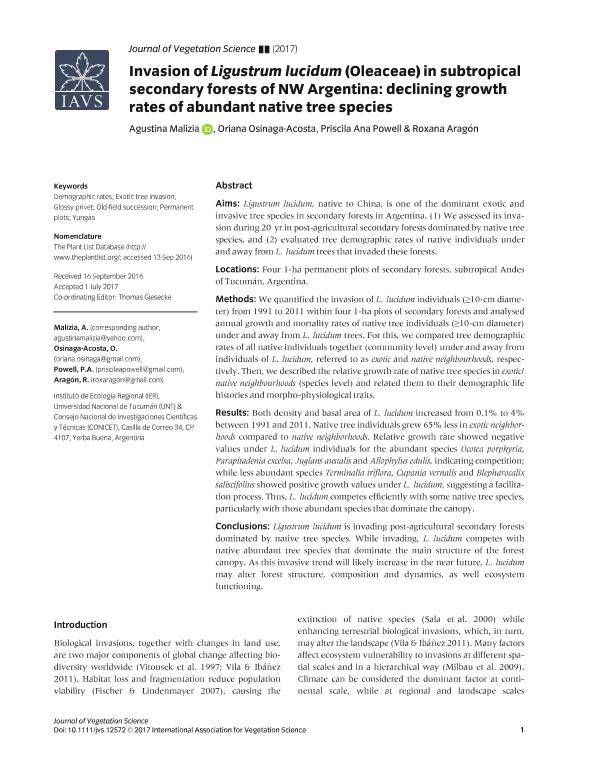Mostrar el registro sencillo del ítem
dc.contributor.author
Malizia, Agustina

dc.contributor.author
Osinaga Acosta, Oriana

dc.contributor.author
Powell, Priscila Ana

dc.contributor.author
Aragón, Myriam Roxana

dc.date.available
2018-12-12T18:20:00Z
dc.date.issued
2017-11
dc.identifier.citation
Malizia, Agustina; Osinaga Acosta, Oriana; Powell, Priscila Ana; Aragón, Myriam Roxana; Invasion of Ligustrum lucidum (Oleaceae) in subtropical secondary forests of NW Argentina: declining growth rates of abundant native tree species; Wiley Blackwell Publishing, Inc; Journal of Vegetation Science; 28; 6; 11-2017; 1240-1249
dc.identifier.issn
1100-9233
dc.identifier.uri
http://hdl.handle.net/11336/66349
dc.description.abstract
Aims: Ligustrum lucidum, native to China, is one of the dominant exotic and invasive tree species in secondary forests in Argentina. (1) We assessed its invasion during 20 yr in post-agricultural secondary forests dominated by native tree species, and (2) evaluated tree demographic rates of native individuals under and away from L. lucidum trees that invaded these forests. Locations: Four 1-ha permanent plots of secondary forests, subtropical Andes of Tucumán, Argentina. Methods: We quantified the invasion of L. lucidum individuals (≥10-cm diameter) from 1991 to 2011 within four 1-ha plots of secondary forests and analysed annual growth and mortality rates of native tree individuals (≥10-cm diameter) under and away from L. lucidum trees. For this, we compared tree demographic rates of all native individuals together (community level) under and away from individuals of L. lucidum, referred to as exotic and native neighbourhoods, respectively. Then, we described the relative growth rate of native tree species in exotic/native neighbourhoods (species level) and related them to their demographic life histories and morpho-physiological traits. Results: Both density and basal area of L. lucidum increased from 0.1% to 4% between 1991 and 2011. Native tree individuals grew 65% less in exotic neighborhoods compared to native neighborhoods. Relative growth rate showed negative values under L. lucidum individuals for the abundant species Ocotea porphyria, Parapitadenia excelsa, Juglans austalis and Allophylus edulis, indicating competition; while less abundant species Terminalia triflora, Cupania vernalis and Blepharocalix saliscifolius showed positive growth values under L. lucidum, suggesting a facilitation process. Thus, L. lucidum competes efficiently with some native tree species, particularly with those abundant species that dominate the canopy. Conclusions: Ligustrum lucidum is invading post-agricultural secondary forests dominated by native tree species. While invading, L. lucidum competes with native abundant tree species that dominate the main structure of the forest canopy. As this invasive trend will likely increase in the near future, L. lucidum may alter forest structure, composition and dynamics, as well ecosystem functioning.
dc.format
application/pdf
dc.language.iso
eng
dc.publisher
Wiley Blackwell Publishing, Inc

dc.rights
info:eu-repo/semantics/openAccess
dc.rights.uri
https://creativecommons.org/licenses/by-nc-sa/2.5/ar/
dc.subject
Demographic Rates
dc.subject
Exotic Tree Invasion
dc.subject
Glossy Privet
dc.subject
Old-Field Succession
dc.subject
Permanent Plots
dc.subject
Yungas
dc.subject.classification
Otras Ciencias Biológicas

dc.subject.classification
Ciencias Biológicas

dc.subject.classification
CIENCIAS NATURALES Y EXACTAS

dc.subject.classification
Otras Ciencias Biológicas

dc.subject.classification
Ciencias Biológicas

dc.subject.classification
CIENCIAS NATURALES Y EXACTAS

dc.title
Invasion of Ligustrum lucidum (Oleaceae) in subtropical secondary forests of NW Argentina: declining growth rates of abundant native tree species
dc.type
info:eu-repo/semantics/article
dc.type
info:ar-repo/semantics/artículo
dc.type
info:eu-repo/semantics/publishedVersion
dc.date.updated
2018-10-23T20:39:12Z
dc.identifier.eissn
1654-1103
dc.journal.volume
28
dc.journal.number
6
dc.journal.pagination
1240-1249
dc.journal.pais
Reino Unido

dc.journal.ciudad
Londres
dc.description.fil
Fil: Malizia, Agustina. Universidad Nacional de Tucumán. Instituto de Ecología Regional. Consejo Nacional de Investigaciones Científicas y Técnicas. Centro Científico Tecnológico Conicet - Tucumán. Instituto de Ecología Regional; Argentina
dc.description.fil
Fil: Osinaga Acosta, Oriana. Universidad Nacional de Tucumán. Instituto de Ecología Regional. Consejo Nacional de Investigaciones Científicas y Técnicas. Centro Científico Tecnológico Conicet - Tucumán. Instituto de Ecología Regional; Argentina
dc.description.fil
Fil: Powell, Priscila Ana. Universidad Nacional de Tucumán. Instituto de Ecología Regional. Consejo Nacional de Investigaciones Científicas y Técnicas. Centro Científico Tecnológico Conicet - Tucumán. Instituto de Ecología Regional; Argentina
dc.description.fil
Fil: Aragón, Myriam Roxana. Universidad Nacional de Tucumán. Instituto de Ecología Regional. Consejo Nacional de Investigaciones Científicas y Técnicas. Centro Científico Tecnológico Conicet - Tucumán. Instituto de Ecología Regional; Argentina
dc.journal.title
Journal of Vegetation Science

dc.relation.alternativeid
info:eu-repo/semantics/altIdentifier/url/http://doi.wiley.com/10.1111/jvs.12572
dc.relation.alternativeid
info:eu-repo/semantics/altIdentifier/doi/http://dx.doi.org/10.1111/jvs.12572
Archivos asociados
